| Article ID | Journal | Published Year | Pages | File Type |
|---|---|---|---|---|
| 2437849 | Journal of Comparative Pathology | 2012 | 4 Pages |
Abstract
Two black bearded sakis (Chiropotes satanas), kept in the same cage in a zoological park, developed multifocal subcutaneous nodular lesions and were diagnosed as having mycobacterial infection by microscopical examination of tissues and 16S rRNA polymerase chain reaction (PCR) and subsequent sequencing of amplicons. One animal died despite both being treated with prolonged antimicrobial therapy. This animal had disseminated disease with lesions in the liver, spleen, lymph nodes and brain. The lesions were granulomatous in nature, but organisms were not identified by acid-fast staining other than on an impression smear of one of the skin nodules. The granulomatous lesions lacked epithelioid macrophages, multinucleated giant cells and fibrous encapsulation. Mycobacterium kansasii was identified by PCR in the lymph nodes of the animal with disseminated disease. Mycobacterial speciation was not as readily achieved in the animal with cutaneous nodules only.
Related Topics
Life Sciences
Agricultural and Biological Sciences
Animal Science and Zoology
Authors
A. Murai, T. Murakami, M. Inoue, H. Ueda, S. Shiihara, J. Kimura, A. Hirata, H. Sakai, T. Yanai,
